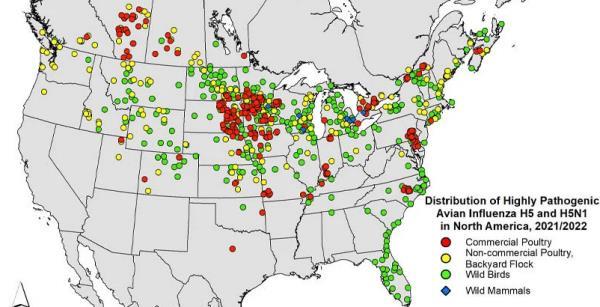 Dr. John R. Clifford, former Chief Veterinary Officer for the USDA and now Chief Trade Policy Advisor for the USAPEEC recently commented on progress in facilitating exports in the face of HPAI. Since the 2015 epornitic, The Animal Plant Health Inspection Service (APHIS) has negotiated agreements with 80 nations to apply regionalization (zoning) in the event of outbreaks. Notwithstanding the acceptance of World Organization of Animal Health principles and policy, China has continued to impose widespread restrictions on both regions and facilities without regard to scientific reality and inconsistent with other importing nations.
Dr. John R. Clifford, former Chief Veterinary Officer for the USDA and now Chief Trade Policy Advisor for the USAPEEC recently commented on progress in facilitating exports in the face of HPAI. Since the 2015 epornitic, The Animal Plant Health Inspection Service (APHIS) has negotiated agreements with 80 nations to apply regionalization (zoning) in the event of outbreaks. Notwithstanding the acceptance of World Organization of Animal Health principles and policy, China has continued to impose widespread restrictions on both regions and facilities without regard to scientific reality and inconsistent with other importing nations.
In his position as an advisor to USAPEEC, Dr. Clifford is obviously influenced by the relative magnitude of broiler exports relative to eggs and turkeys that were the most severely affected segments in the 2023 epornitic. Dr. Clifford notes that effective biosecurity is the only current preventive measure. There is anecdotal evidence that egg-production complexes were infected in 2022 despite high levels of structural and operational biosecurity with the implication of aerogenous introduction over short distances that currently is impossible to interdict. Dr. Clifford stated “It (biosecurity) will not eradicate HPAI by itself. It will help reduce HPAI, but it will not eradicate it. The best way to eradicate it is prevention,” It is impossible to eradicate an infection carried by and introduced by migratory free-living birds on a seasonal basis. Neither will mass depopulation that serves as a control measure to limit lateral dissemination to adjacent farms. If the objective is “prevention” then surely creating an immune population in susceptible regions coupled with biosecurity would represent an advance over the current costly “whack-a mole” approach to control.
 |
He is clearly and justifiably concerned over the implications of applying vaccination as an adjunct to existing prevention measures. Given that HPAI has become regionally and seasonally endemic in many nations, vaccination is now applied in many locations and situations affected by the H5N1 strain. His diplomacy, scientific knowledge and credentials could be used to gain acceptance for more extensive vaccination among importing nations. Irrespective of vaccination status it should be possible given the availability of PCR technology, to certify flocks or even an entire complex as being free from avian influenza prior to shipment.
Dr. Clifford points to the potential loss of revenue from the export of broiler leg quarters. He should, however, consider the cost to the U.S. public sector resulting from an epornitic. More importantly, additional expenditure by consumers in the event of restricted supplies of broiler and turkey meat and eggs is an overlooked burden. During 2022, a doubling in the retail price of eggs cost consumers close to $15 billion.
Dr. Clifford also warns of the potential for a mutant strain of avian influenza becoming zoonotic for which there are precedents. The World Health Organization has also expressed concerns over the possibility of a recombinant event involving H5N1. This strain is now panornitic in distribution on six continents with dissemination of the pathogen facilitated by migratory waterfowl and marine birds with the possibility of mammal reservoirs.
Opponents of vaccination are advancing extremely dubious justifications to support their position. Requiring a large number of untrained personnel to depopulate commercial farms affected with HPAI represents a far greater danger to the industry than using crews to vaccinate long-lived flocks applying appropriate biosecurity. In any event, the administration of inactivated vaccine for long-lived would be performed at the same time as existing multivalent products and would not represent a high incremental cost. For short-lived birds including broilers, vaccine could be administered in hatcheries using HVT-vectored in-ovo products.
In the event that North America is subjected to an extensive outbreak of HPAI in the fall of 2023 or subsequently in the spring of 2014, available avian influenza vaccines similar to those in use in numerous nations, should be considered as a tactical measure complementing biosecurity for specific regions and production systems.